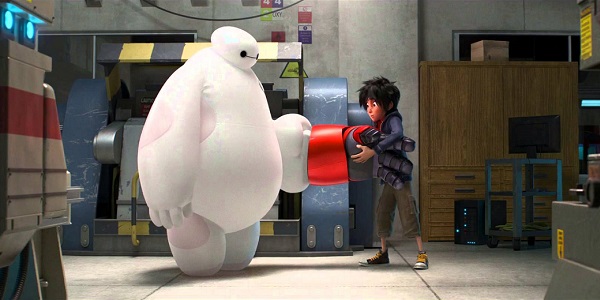The Good Dinosaur (2015)
December 7, 2015 Leave a comment
 66 million years ago an asteroid missed the earth, and its dinosaur inhabitants lived happily ever after. The End. Some time later, on an a remote outpost somewhere in America, three Apatosaurus are born to a family of farmers. The youngest, named Arlo (Raymond Ochoa), is smaller than his siblings, and struggles with his assorted duties, the most recent of which involves guarding the family’s food stores from a pesky hominid (Jack Bright) who keeps helping himself to their corn. When Arlo and Spot (as the former comes to call him) are washed hundreds of miles downriver by floodwater, they must join forces if they are going to make their way back home in time for first snow, and survive encounters with various other dinosaurs looking to fill their stomachs before winter sets in.
66 million years ago an asteroid missed the earth, and its dinosaur inhabitants lived happily ever after. The End. Some time later, on an a remote outpost somewhere in America, three Apatosaurus are born to a family of farmers. The youngest, named Arlo (Raymond Ochoa), is smaller than his siblings, and struggles with his assorted duties, the most recent of which involves guarding the family’s food stores from a pesky hominid (Jack Bright) who keeps helping himself to their corn. When Arlo and Spot (as the former comes to call him) are washed hundreds of miles downriver by floodwater, they must join forces if they are going to make their way back home in time for first snow, and survive encounters with various other dinosaurs looking to fill their stomachs before winter sets in.
Pixar have, by and large, always known which questions to ask of their audience. What do your toys get up to when you’re not around? Why are there monsters under your bed? What exactly is going on inside your head? Obviously, these creative quandaries feed the imagination of young children who don’t know any better, but they are also intuitive and insightful enough to inspire those who really should. At their simplest, the premise of every Pixar film makes sense to children young and old on a level unspoiled by sense or reason. For these are questions that have been asked by all, at one point or another in their lives, whether yesterday or yesteryear. Their latest, The Good Dinosaur, has such a hook — What if the dinosaurs didn’t die out? — but unlike the rest of their set-ups, this one lacks a satisfying answer. Worse than that, it’s not even coherent.
Like the asteroid seen bypassing the planet in its opening moments, The Good Dinosaur is pretty wide of the mark. When you consider the success Pixar has had spit-balling ideas about fish, rats and old people it is quite simply inconceivable that they’d hit a creative wall here, with dinosaurs, and think of nothing better to do than cast them in a western…for some reason. There was that scene in The Lost World: Jurassic Park that saw a pack of velociraptors chase Jeff Goldblum through a cornfield, but generally speaking dinosaurs and farming don’t exactly go hand in hand. That the film conspires to have sauropods plough fields to collect corn, which is then stored in a totemic silo that could not possibly have been built by quadrupeds is just the first in a long line of creative decisions that leave you wondering if you’re watching the latest Blue Sky animation by mistake, or maybe a prehistoric prequel to the studio’s much-maligned Cars series. After all, if dinosaurs can learn to sow and harvest crops, then what’s stopping them from evolving wheels and a thresher? Heck, Tyrannosaur’s can even gallop now.
Director Peter Sohn has clearly gone to great pains to replicate the American northwest setting, to the point that the animation borders on being photorealistic, but rather than show his characters the same reverence he has gone in the opposite direction. Arlo is unmistakably a dinosaur, but the resemblance isn’t much stronger than that of a balloon animal to an actual animal. It’s not just that he’s not particularly visually interesting either; scratch beneath the surface and the whole character just deflates into nothing. Has Pixar ever produced a less compelling protagonist? Not since A Bug’s Life has a main character appeared so anonymous — and that was a film about ants! This is all the more remarkable given how many traits Arlo has in common with Rex, the studio’s only other dinosaur character to date, and one of its best loved. It’s hard to remain focused on someone so plain when there is such depth and detail in the background, and Arlo’s motivations (he wants to put his stamp on the aforementioned silo, but first he has to earn it) are so completely uninvolving that you really do find yourself admiring the river’s keenly observed currents instead.
The Good Dinosaur is not without its moments, most of which can be attributed to the character of Spot (or traced back to an all too fleeting appearance from Forrest Woodbush, a Styracosaurus with serious squad goals, voiced by Sohn himself), but for the most part it fails even to register as entertainment — more a handsome screensaver with a crude cartoon photoshopped onto it. It might not be Pixar’s worst film, but it is certainly their least enjoyable, and not just for the adult contingent left feeling betrayed by a studio that usually caters to all; after the multi-monster melee that closed Jurassic World it’s hard to imagine anyone but the youngest, most unassuming children getting excited about a C-list dinosaur who’s afraid of bloody birds. Even the name is underwhelming: since when did Pixar settle for good?














